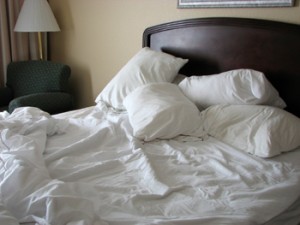 High blood sugar can be a warning sign that a patient is actually suffering from some sort of sleep disorder. Sleep disorders can be caused by other disorders as well. Whether this cause is something as straightforward as obesity with a narrow upper breathing space, or as nuanced as a chronic illness, there are definite links between many physical conditions and sleep disorders. Doctors have long known that diabetes, especially Type 2 diabetes, has a dangerous connection to sleep apnea. A new study published in the medical journal Diabetes Care further expands our understanding of this causal relationship.
High blood sugar can be a warning sign that a patient is actually suffering from some sort of sleep disorder. Sleep disorders can be caused by other disorders as well. Whether this cause is something as straightforward as obesity with a narrow upper breathing space, or as nuanced as a chronic illness, there are definite links between many physical conditions and sleep disorders. Doctors have long known that diabetes, especially Type 2 diabetes, has a dangerous connection to sleep apnea. A new study published in the medical journal Diabetes Care further expands our understanding of this causal relationship.
Even before this study was released, there was a proven correlation between Type 2 Diabetes and sleep apnea, since sleep apnea often occurs in those diabetics who are not properly regulating their glucose levels. By examining how and when sleep apnea affects one’s blood sugar, and his or her ability to control it, this study has broken new ground. It proves that sleep apnea actively makes diabetes worse by interrupting the sleeper’s REM cycle, and with each pause in breathing, the sleeper’s glucose levels fluctuate wildly.
Part of the problem is that the REM stage of sleep is when most patients removed their CPAP mask (continuous positive airway pressure), instead of wearing it through the night. Once the mask is off sleep apnea reasserts itself, and in turn negatively impacts the ability to control one’s blood sugar.
So those patients who suffer both Type 2 Diabetes and sleep apnea are strongly encouraged to take steps to ensure their CPAP mask is firmly in place for the entirety of the night. This can be harder than it sounds, since many patients are not even conscious that they are removing their masks, but are merely reacting on instinct to a perceived discomfort on their face. By brushing away the mask, they are putting themselves at a heightened risk.
Again, what makes this link between sleep apnea and diabetes so dangerous is that the two conditions feed into one another. Having an uninterrupted REM cycle is crucial for maintaining stable glucose level, but the REM stage is when most patients removed their CPAP masks. With the mask removed, the patients then felt the full effect of their sleep apnea, which in turn interrupted the REM cycle, and compromised their blood sugar. The good news is that this study has proven beyond a doubt that if you have obstructive sleep apnea and diabetes, you can better control your blood sugar levels and simultaneously keep your sleep apnea in check if you wear your CPAP mask through the night.
At Rowe Neurology Institute, we have the most current diagnostic tools for the diagnosis of sleep disorders, and a staff of neurologists and integrated caregivers who specialize in sleep disorders. We perform 1,500 in lab sleep studies annually in our nationally accredited sleep disorders center. We believe it’s extremely important for patients to see their sleep studies in detail. So they can be their best selves and have a full understanding of their sleep disorders. We show them how.